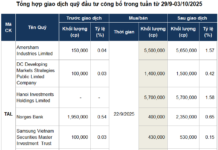Despite these risks, the Mekong Delta faces a huge demand for sand for infrastructure and economic projects. The shortage of sand over the past year has affected the progress of many projects in the region, requiring alternative solutions to balance development and ecosystem protection.

Erosion at Son Con on the Hau River (between Can Tho and Vinh Long) has reduced its area. Photo: Hoa Hoi
Living on alluvial fans, the locals enjoy the benefits of nature’s bounty with lush greenery and fruitful trees all year round. However, in recent years, many fans in the Mekong Delta are shrinking due to erosion, causing people to lose their land and homes, partly due to illegal sand exploitation.
Losing Land and Homes
In the middle of the night in July 2024, the loud sound of an engine broke the silence on the dark Co Chien River. It was a sand thief sucking up sand illegally. After receiving a tip-off, the An Phuoc Commune Police (Mang Thit District, Vinh Long Province) and Mr. Nam, a local resident (name changed for privacy), hid and caught a sand barge stealing sand at the head of Kien Con (in the waters of Tan Thieng Commune, Cho Lach District, Ben Tre Province).
After catching them red-handed, the police mobilized over a dozen people to the scene for support. A few strange men also surrounded the stolen sand barge. It took the authorities almost five hours to complete the paperwork and force the sand thieves’ barge to the temporary holding area, protecting the informants as the thieves could have sunk their boat as a cover-up for a nighttime river accident.
According to local police, sand thieves have lookouts who monitor the authorities and prevent locals from interfering. In the first six months of 2024, Mang Thit District Police caught about ten cases of illegal sand extraction, six of which were caught by An Phuoc Commune Police alone.

Local people of Son Con reinforce the embankment at the head of the fan to prevent erosion in early June 2024
Mr. Nam took us on his boat around Kien Con, located in the middle of the Co Chien River (adjacent to Ben Tre and Vinh Long Provinces). He pointed out the treetops protruding from the water and recalled that this fan used to be over 30 hectares, stretching over a kilometer upstream from its current location. In the past, even though there were times when one side of the fan eroded while the other side expanded, the fan continued to grow. Mr. Nam is the third generation to pioneer and develop the economy on this fan. The land on Kien Con is fertile, and the trees bear fruit all year round. However, in the last decade, due to rampant illegal sand extraction, the fan has been eroding, losing several dozen meters of land each year on all four sides. As a result, the fan is now only about 10 hectares in size.
In 2009, Mr. Nam’s house on Kien Con, inherited from his older brother, was also pulled down by erosion, forcing the family to move back to the shore. The small strip of land remaining on the fan is still being cultivated, but it continues to shrink with each passing flood season. “My family’s land, which was lush and located near the center of the fan, is now at the river’s edge and has also diminished. The land of other households on the outskirts has disappeared entirely. If the sand thieves continue like this, Kien Con will be gone in a few years. I stay up every night to watch for sand thieves, and when I hear the sound of their machines, I report it to the police. But they know when I’m busy and unable to keep watch, and that’s when they strike,” Mr. Nam said.
A few hundred meters from Mr. Nam’s house, Mr. L.V.T owns 1.3 hectares of land on Kien Con. He has been living on the fan for over 30 years, but in recent years, despite his significant investments in reinforcement, his land continues to erode. “Before, they used to steal sand from the middle of the river, but now they’re running rampant with their hoses right at the edge of the fan, causing the land to collapse into the river. I don’t know how much longer my house and land will last,” Mr. T said sadly.
From the end of 2023 to the present, many localities in the Mekong Delta have had to declare emergencies due to erosion and subsidence. Most recently, on July 29, the People’s Committee of Vinh Long Province declared an emergency due to erosion along the La Ghi canal in Vinh Xuan commune, Tra On district. In June, the province also declared an emergency due to erosion along the Mang Thit River in Tan An Luong commune, Vung Liem district.
On July 26, the People’s Committee of Tra Vinh Province declared an emergency due to erosion along the Hau River in Ninh Thoi and Hoa Tan communes, Cau Ke district. In November 2023, the province also declared an emergency due to erosion along the seawall in Hiep Thanh commune, Duyen Hai town.
In April, the People’s Committee of Ca Mau Province declared an emergency due to drought and subsidence in Tran Van Thoi and U Minh districts; while the People’s Committee of Kien Giang Province declared an emergency due to erosion and subsidence in the U Minh Thuong buffer zone. At the end of 2023, the People’s Committee of Ben Tre Province declared an emergency due to coastal erosion in Ba Tri district and riverbank erosion along the Giao Hoa River in Chau Thanh district.
Mekong Delta Correspondent Team
Living in Fear
In Can Tho City, in the early morning of June 2024, a section of the dike at the head of Son Con (Bui Huu Nghia Ward, Binh Thuy District) collapsed. Upon receiving the news, the locals rushed to reinforce it. “If this dike breaks, the fish pond inside will become part of the river, and the power line connecting the mainland to the fan will be at risk,” said Mr. Ly Van Bon (known as Bay Bon), who has lived on Son Con for over 30 years.
Mr. Bon shared that Son Con, located in the middle of the Hau River (adjacent to Can Tho and Vinh Long Provinces), is currently about 100 hectares in size and home to more than 65 households, most of whom have developed eco-tourism. Mr. Bon recalled that 30 years ago, when he first set foot on Son Con, it was much larger, stretching from Tra Noc estuary (Binh Thuy District, Can Tho City) – nearly four kilometers from its current location. However, due to erosion, the land on the fan has been gradually slipping into the river, forcing many households to move back to the mainland to make a living. “If this continues at the current rate, Son Con will disappear in about 20 years,” Mr. Bon said.

Severe erosion at the end of Son Con, with many large trees planted for years being pulled down, leaving only the treetops above the water. Photo: Hoa Hoi
According to Mr. Bon, in recent years, the erosion has been very unpredictable. In the past, when one end of the fan eroded, the other end expanded, or when the Vinh Long side eroded, the Can Tho side expanded, and vice versa. However, recently, all four sides have been eroding simultaneously, and the rate of erosion has been increasing, defying natural laws. There are now many “caves” along the shore of Son Con, and the riverbed is deep, making it prone to sudden collapses.
Mr. Nguyen Thanh Tam’s house at the head of Son Con (upstream) also suffered erosion just a few days ago. Mr. Tam shared that his 88-year-old father was one of the first pioneers to settle on this fan. Mr. Tam is worried that he doesn’t know when the erosion will reach his house.
The locals took us on a boat ride around Son Con to observe the situation. We witnessed several severe erosion sites, especially at the end of Son Con, which has changed significantly. In the past, the lower end of the fan used to accumulate alluvial soil, expanding the land. However, in the last few years, the end of Son Con has also been eroding, cutting several hundred meters into the fan and creating a steep riverbank.
(To be continued)
Urgent Momentum on the Construction Site of the Hau River Bridge
In the scorching heat and gusty wind of the southwestern region in the days leading up to the 2024 Lunar New Year, there is a bustling construction site not far from the beach. Over 300 dedicated workers and staff are diligently working on the construction of the Dai Ngai Bridge, which will soon connect the two banks of the Hau River.










































